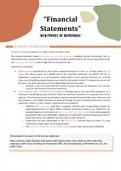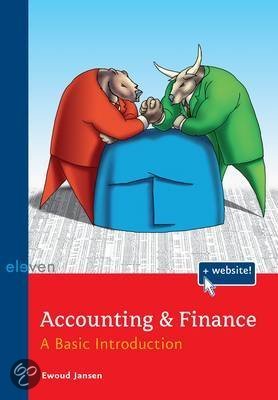“Financial
Statements”
“KEY POINTS TO REMEMBER”
Income Statement
à result is to show how profitable you are (affects equity on the balance sheet)
The income statement shows total revenues and total expenses, including noncash accounting, such as
depreciation over a period of time. Your transactions should be represented on the income statement if they
are incurred in that period, even though they are not paid for yet.
Important to remember:
• Depreciation is represented on the income statement because it is the cost of fixed assets (loss of
value) and affects equity. (It is NEVER part of the cash flow statement. You DON’T PAY for it.
Explanation: a payment is a cash transaction. Depreciation is not a payment because it is noncash
(=you are not spending money because your asset has decreased in value). As long as you do not sell
the asset, you won’t lose money if it has depreciated, but you lose value.
o (However, if you sell an asset AND sell it below its current value you will experience a loss, and this
should be represented on the income statement).
• Costs of goods sold is different from purchases! Purchases go on the cash flow statement, so a
purchase is something you pay money for. When you purchase inventory, it is a payment but not an
expense. This is because you are purchasing an asset (investment) that still holds value. When you sell
that inventory, only THEN it becomes an expense through the Cost of Goods Sold account (income
statement). When it is sold, it doesn’t hold value for you anymore.
o Definition of investment: asset that is acquired with the goal of generating income (or
appreciation/increase of value). When someone purchases a good as an investment, for
example equipment, the intent is to use it in the future to create wealth (you need equipment
to generate sales more efficiently). Simply put: an investment could start paying you back; it
holds some value. And expenses will only drain on your resources.
o Investments are also represented on the balance sheet because they are assets. If a new
investment is made, add it to the balance sheet.
o The costs of an investment can be depreciation: a loss of value means less profitability.
# Examples of accounts on the income statement:
"
Sales revenue, costs of goods sold, gross profit, depreciation, rent, salaries, other operating
expenses, profit / loss of selling an investment, EBIT, interest expenses, profit before tax, tax, net
profit / loss





